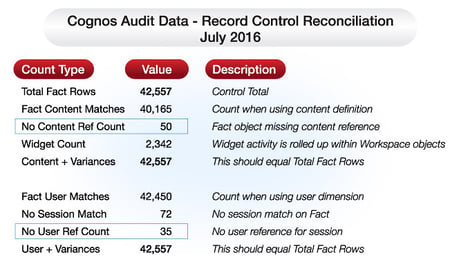 Of all the subjects in the area of Cognos administration, Audit Data consistently ranks at or near the top of the list on Google searches where the subject is Cognos. People are looking for information to both understand it, and ultimately, to learn how to use it. Interestingly, audit data has never been a subject that’s been covered in any depth in IBM Cognos training courses except on how to set up logging when configuring your Cognos environment. The basic audit data be very useful, but when coupled with other data available from your Cognos environment it can be used in some very creative ways. In fact, there are no limits to what you can do with it.
Of all the subjects in the area of Cognos administration, Audit Data consistently ranks at or near the top of the list on Google searches where the subject is Cognos. People are looking for information to both understand it, and ultimately, to learn how to use it. Interestingly, audit data has never been a subject that’s been covered in any depth in IBM Cognos training courses except on how to set up logging when configuring your Cognos environment. The basic audit data be very useful, but when coupled with other data available from your Cognos environment it can be used in some very creative ways. In fact, there are no limits to what you can do with it.
Virtually all large, complex software systems have logs that provide information that can be used debugging, data mining and analysis. When an application or system crashes the causal error can often be found in the log. If and when performance becomes an issue the logs can also be useful in diagnosing the problem and improving performance.
Cognos is no different. There are many different types, targets and levels of Cognos logging. It has the basics like error reporting and timestamps which can isolate performance issues but it also contains some other things. For example, it can tell you when reports were run, when users logged on, when changes were made to objects and many other things. Using this data you can start collecting statistics about how your environment is used and start to keep track of what is happening without having to resort to guessing.
The logging configuration in Cognos Configuration can be configured with multiple different targets of various types. It can be configured to write to the system log, a named windows event log, or a SQL database. Using an SQL database will let you then consume the data using the Cognos tools you're already familiar with and using – Framework Manager, Datasources, and Report and Query Studio. They provide a handful of reports which can be run to start understanding who, how, and when your Cognos environment is being used.
Read More >
This rich dimensionality is what makes it possible to answer virtually any question about the audit data and what’s being used in your Cognos environment. And there are a number of real world examples where data from a given dimension can be very useful. Whether it’s usage by user, by package, by dispatcher or object type.
Read More >
The value of Cognos audit data goes far beyond what is available from the audit tables. Somethings to focus on include:
Once you’ve created the appropriate dimensions and measures to use with the Cognos audit data the creative opportunities are limited only by your imagination and real needs. Focus on those that represent real opportunities to expand user adoption and remove problems that get in the way of users.
Read More >
UniVisn covers all key performance areas, making it easy to mix and match charts, graphs and reports to get exactly what you need. Summary and detail performance information at your fingertips driven by rock solid data you can rely on.

See how UniVisn can simplify your audit data needs!
Request a Demo
Support
512-991-3999
info@envisn.com
3000 Polar Lane, Suite 901, Cedar Park, TX 78613 USA
Serving North America, Europe, and the UK with plans to expand to other areas in the near future. Privacy, Copyright & Liability